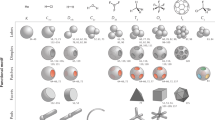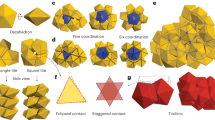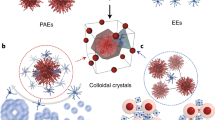Abstract
The ability to design and assemble three-dimensional structures from colloidal particles is limited by the absence of specific directional bonds. As a result, complex or low-coordination structures, common in atomic and molecular systems, are rare in the colloidal domain. Here we demonstrate a general method for creating the colloidal analogues of atoms with valence: colloidal particles with chemically distinct surface patches that imitate hybridized atomic orbitals, including sp, sp2, sp3, sp3d, sp3d2 and sp3d3. Functionalized with DNA with single-stranded sticky ends, patches on different particles can form highly directional bonds through programmable, specific and reversible DNA hybridization. These features allow the particles to self-assemble into ‘colloidal molecules’ with triangular, tetrahedral and other bonding symmetries, and should also give access to a rich variety of new microstructured colloidal materials.
This is a preview of subscription content, access via your institution
Access options
Subscribe to this journal
Receive 51 print issues and online access
$199.00 per year
only $3.90 per issue
Buy this article
- Purchase on Springer Link
- Instant access to full article PDF
Prices may be subject to local taxes which are calculated during checkout




Similar content being viewed by others
References
Glotzer, S. C. & Solomon, M. J. Anisotropy of building blocks and their assembly into complex structures. Nature Mater. 6, 557–562 (2007)
Sacanna, S. & Pine, D. J. Shape-anisotropic colloids: building blocks for complex assemblies. Curr. Opin. Colloid Interf. Sci. 16, 96–105 (2011)
Rossi, L. et al. Cubic crystals from cubic colloids. Soft Matter 7, 4139–4142 (2011)
Meng, G., Arkus, N., Brenner, M. P. & Manoharan, V. N. The free-energy landscape of clusters of attractive hard spheres. Science 327, 560–563 (2010)
Manoharan, V. N., Elsesser, M. T. & Pine, D. J. Dense packing and symmetry in small clusters of microspheres. Science 301, 483–487 (2003)
Kraft, D. J. et al. Self-assembly of colloids with liquid protrusions. J. Am. Chem. Soc. 131, 1182–1186 (2009)
Sacanna, S., Irvine, W. T. M., Chaikin, P. M. & Pine, D. J. Lock and key colloids. Nature 464, 575–578 (2010)
Zoldesi, C. I., van Walree, C. A. & Imhof, A. Deformable hollow hybrid silica/siloxane colloids by emulsion templating. Langmuir 22, 4343–4352 (2006)
Li, F., Josephson, D. P. & Stein, A. Colloidal assembly: the road from particles to colloidal molecules and crystals. Angew. Chem. Int. Edn 50, 360–388 (2011)
Leunissen, M. E. et al. Ionic colloidal crystals of oppositely charged particles. Nature 437, 235–240 (2005)
Macfarlane, R. J. et al. Nanoparticle superlattice engineering with DNA. Science 334, 204–208 (2011)
Velikov, K. P., Christova, C. G., Dullens, R. P. A. & van Blaaderen, A. Layer-by-layer growth of binary colloidal crystals. Science 296, 106–109 (2002)
Ho, K. M., Chan, C. T. & Soukoulis, C. M. Existence of a photonic gap in periodic dielectric structures. Phys. Rev. Lett. 65, 3152–3155 (1990)
Nelson, D. R. Toward a tetravalent chemistry of colloids. Nano Lett. 2, 1125–1129 (2002)
Glotzer, S. C. Some assembly required. Science 306, 419–420 (2004)
Manoharan, V. N. Building Materials with Colloidal Spheres. PhD thesis, Univ. California, Santa Barbara. (2004)
Breed, D. R. Engineered Colloids: Patchy Particles with Reversible, Directional Interactions. PhD thesis, Univ. California, Santa Barbara. (2007)
Bianchi, E., Blaak, R. & Likos, C. N. Patchy colloids: state of the art and perspectives. Phys. Chem. Chem. Phys. 13, 6397–6410 (2011)
Zhang, Z. & Glotzer, S. C. Self-assembly of patchy particles. Nano Lett. 4, 1407–1413 (2004)
Xu, X., Rosi, N. L., Wang, Y., Huo, F. & Mirkin, C. A. Asymmetric functionalization of gold nanoparticles with oligonucleotides. J. Am. Chem. Soc. 128, 9286–9287 (2006)
Huo, F., Lytton-Jean, A. K. R. & Mirkin, C. A. Asymmetric functionalization of nanoparticles based on thermally addressable DNA interconnects. Adv. Mater. 18, 2304–2306 (2006)
Hong, L., Cacciuto, A., Luijten, E. & Granick, S. Clusters of amphiphilic colloidal spheres. Langmuir 24, 621–625 (2008)
Chen, Q., Bae, S. C. & Granick, S. Directed self-assembly of a colloidal kagome lattice. Nature 469, 381–384 (2011)
Jones, M. R., Macfarlane, R. J., Prigodich, A. E., Patel, P. C. & Mirkin, C. A. Nanoparticle shape anisotropy dictates the collective behavior of surface-bound ligands. J. Am. Chem. Soc. 133, 18865–18869 (2011)
Kraft, D. J., Groenewold, J. & Kegel, W. K. Colloidal molecules with well-controlled bond angles. Soft Matter 5, 3823–3826 (2009)
Cho, Y.-S. et al. Particles with coordinated patches or windows from oil-in-water emulsions. Chem. Mater. 19, 3183–3193 (2007)
Zhang, G., Wang, D. & Möhwald, H. Patterning microsphere surfaces by templating colloidal crystals. Nano Lett. 5, 143–146 (2005)
Pawar, A. B. & Kretzschmar, I. Multifunctional patchy particles by glancing angle deposition. Langmuir 25, 9057–9063 (2009)
Pawar, A. B. & Kretzschmar, I. Fabrication, assembly, and application of patchy particles. Macromol. Rapid Commun. 31, 150–168 (2010)
Ottewill, R. & Shaw, J. Studies on the preparation and characterization of monodisperse polystyrene lattices. Colloid Polym. Sci. 215, 161–166 (1967)
Ugelstad, J., Kaggerud, K. H., Hansen, F. K. & Berge, A. Absorption of low molecular weight compounds in aqueous dispersions of polymer-oligomer particles, 2: A two step swelling process of polymer particles giving an enormous increase in absorption capacity. Makromol. Chem. 180, 737–744 (1979)
Ugelstad, J. et al. Thermodynamics of swelling. Preparation and application of some composite, monosized polymer particles. Makromol. Chem. 10, 215–234 (1985)
Walther, A. & Muller, A. H. E. Janus particles. Soft Matter 4, 663–668 (2008)
Zerrouki, D. et al. Preparation of doublet, triangular, and tetrahedral colloidal clusters by controlled emulsification. Langmuir 22, 57–62 (2006)
Mirkin, C. A., Letsinger, R. L., Mucic, R. C. & Storhoff, J. J. A DNA-based method for rationally assembling nanoparticles into macroscopic materials. Nature 382, 607–609 (1996)
Alivisatos, A. P. et al. Organization of ‘nanocrystal molecules’ using DNA. Nature 382, 609–611 (1996)
Leunissen, M. E. et al. Switchable self-protected attractions in DNA-functionalized colloids. Nature Mater. 8, 590–595 (2009)
Nykypanchuk, D., Maye, M. M., van der Lelie, D. & Gang, O. DNA-guided crystallization of colloidal nanoparticles. Nature 451, 549–552 (2008)
Zhang, Z., Keys, A. S., Chen, T. & Glotzer, S. C. Self-assembly of patchy particles into diamond structures through molecular mimicry. Langmuir 21, 11547–11551 (2005)
Chen, Q. et al. Supracolloidal reaction kinetics of Janus spheres. Science 331, 199–202 (2011)
Dreyfus, R. et al. Aggregation-disaggregation transition of DNA-coated colloids: Experiments and theory. Phys. Rev. E 81, 041404 (2010)
van Kampen, N. G. Stochastic Processes in Physics and Chemistry 3rd edn, 292–297 (Elsevier, 2007)
Romano, F., Sanz, E. & Sciortino, F. Crystallization of tetrahedral patchy particles in silico. J. Chem. Phys. 134, 174502–174508 (2011)
Johnson, P. M., van Kats, C. M. & van Blaaderen, A. Synthesis of colloidal silica dumbbells. Langmuir 21, 11510–11517 (2005)
Perro, A. et al. A chemical synthetic route towards “colloidal molecules”. Angew. Chem. Int. Edn 48, 361–365 (2009)
Frenkel, D. Playing tricks with designer “atoms”. Science 296, 65–66 (2002)
Miller, M. A. & Wales, D. J. Novel structural motifs in clusters of dipolar spheres: knots, links, and coils. J. Phys. Chem. B 109, 23109–23112 (2005)
Acknowledgements
We thank M. T. Elsesser, D. Kraft, and G.-R. Yi for discussions. This work was supported partially by the MRSEC Program of the National Science Foundation under award number DMR-0820341. Additional financial support was provided by the National Science Foundation (ChE-0911460). We acknowledge support from the MRI programme of the National Science Foundation under award number DMR-0923251 for the purchase of a Zeiss field emission scanning electron microscope.
Author information
Authors and Affiliations
Contributions
V.N.M. and D.J.P. thought of patchy particles and how to make them. D.R.B. developed the functionalization of patches. Yufeng Wang and Yu Wang optimized the control of patch size and DNA functionalization, performed the experiments, and collected and analysed the data. A.D.H. helped with particle synthesis. L.F. designed the DNA sequences and modelled the kinetics. M.W. and D.J.P. supervised the project. D.J.P., Yufeng Wang and Yu Wang wrote the paper with revisions from all of the authors.
Corresponding authors
Ethics declarations
Competing interests
The authors declare no competing financial interests.
Supplementary information
Supplementary Information
This file contains Supplementary Figures 1-5, Supplementary Equation 1 and Supplementary Table 1. (PDF 8222 kb)
ABn colloidal molecules
A collection of ABn (n=1-4) colloidal molecules assembled from monovalent, divalent, trivalent or tetravalent particles at the central position. Particles were suspended in an aqueous PBS buffer solution (pH=7.4) containing surfactant (1% w/w Pluronic F127). The system had been stabilized for a few hours at 25˚C and the video was taken at 25˚C. The video is acquired and displayed at real time. Scale bar, 2 μm. (MOV 2646 kb)
Kinetics of AB4 colloidal molecule formation
Starting from a bare tetravalent particle, the kinetics is followed as four monovalent particles are assembled onto the tetravalent particle successively. The time intervals between each set of clips are indicated below the videos. Particles were suspended in an aqueous PBS buffer solution (pH=7.4) containing surfactant (1% w/w Pluronic F127). The video was taken at 25˚C, immediately after a rapid quench from 55˚C. The video is acquired at 24 fr/s and played at a rate shown in the upper left corner. Scale bar, 3 μm. (MOV 8191 kb)
Polymerization kinetics of the assembly of complementary divalent particles
A linear polymer chain starts from a divalent particle, which picks up other single divalent particles sequentially. Particles were suspended in an aqueous PBS buffer solution (pH=7.4) containing surfactant (1% w/w Pluronic F127). The video was taken at 25˚C, immediately after a rapid quench from 55˚C. The video is acquired at 10 fr/s and played at a rate indicated in the lower left corner. Scale bar, 2 μm. (MOV 7971 kb)
Kinetics of AB3 colloidal molecule formation
Trivalent particles act as central atoms, picking up monovalent particles one at a time. Most trivalent particles assemble a monovalent particle before the first trivalent particles pick up a second monovalent one. The same is true for the next assembly step. Only after most trivalent particles have acquired two monovalent particles do third particles begin to attach. Particles were suspended in an aqueous PBS buffer solution (pH=7.4) containing surfactant (1% w/w Pluronic F127). The video was taken at 25˚C, immediately after a rapid quench from 55˚C. The video is acquired at 24 fr/s and played at a rate indicated in the lower left corner. Scale bar, 3 μm. (MOV 14804 kb)
Rights and permissions
About this article
Cite this article
Wang, Y., Wang, Y., Breed, D. et al. Colloids with valence and specific directional bonding. Nature 491, 51–55 (2012). https://doi.org/10.1038/nature11564
Received:
Accepted:
Published:
Issue Date:
DOI: https://doi.org/10.1038/nature11564
This article is cited by
-
Clustering of charged colloidal particles in the microgravity environment of space
npj Microgravity (2023)
-
Visualizing defect dynamics by assembling the colloidal graphene lattice
Nature Communications (2023)
-
Creating bulk ultrastable glasses by random particle bonding
Nature Communications (2023)
-
Synthesis of branched silica nanotrees using a nanodroplet sequential fusion strategy
Nature Synthesis (2023)
-
Microrobots powered by concentration polarization electrophoresis (CPEP)
Nature Communications (2023)
Comments
By submitting a comment you agree to abide by our Terms and Community Guidelines. If you find something abusive or that does not comply with our terms or guidelines please flag it as inappropriate.



